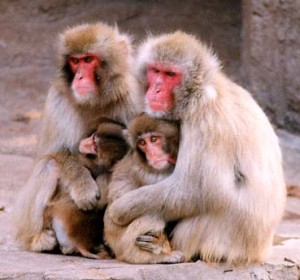02. 2014年7月26日 08:53:20
: nJF6kGWndY
なるほどimmature の場合は、逆相関が見える1000Bq/kgだと40を超えるものが見えないところを見ると 何らかの造血細胞の分化を阻害する効果があるのかもしれない 今後は、発がん率などとの相関も調べるべきだろう
あとヒトで、これほど高度に被曝した例はほとんどないだろうが
血液検査で網羅的に相関を調べてみる価値はあるな http://www.nature.com/srep/2014/140724/srep05793/fig_tab/srep05793_F2.html
White blood cell counts and muscle radiocesium concentrations in immature Japanese monkeys captured in Fukushima. Table 3: Correlation between muscle radiocesium concentration and hematological values in Fukushima monkeys
From
Low blood cell counts in wild Japanese monkeys after the Fukushima Daiichi nuclear disaster
Kazuhiko Ochiai, Shin-ichi Hayama, Sachie Nakiri, Setsuko Nakanishi, Naomi Ishii, Taiki Uno, Takuya Kato, Fumiharu Konno, Yoshi Kawamoto, Shuichi Tsuchida & Toshinori Omi
Scientific Reports 4, Article number: 5793 doi:10.1038/srep05793
Received 06 February 2014 Accepted 24 June 2014 Published 24 July 2014
back to article
Table 3: Correlation between muscle radiocesium concentration and hematological values in Fukushima monkeys
RBC Hb Ht Cs
n r p n r p n r p n r p
Pearson's correlation coefficient (r) was calculated to show correlation between muscle radiocesium concentrations and hematological values for each age group. WBC, white blood cell count; RBC, red blood cell count; Hb, hemoglobin; Ht, hematocrit; Cs, muscle radiocesium concentration; n, number of individuals; p, p values. Immature
WBC 22 0.430 0.045 21 0.501 0.021 22 0.526 0.012 23 −0.520 0.011
RBC 22 0.967 5 years). Furthermore, we calculated fat indices to evaluate monkeys' nutritional status. In the previous study20, the ratio of mesenteric fat weight to body weight is proportional to the percentage of body fat in Japanese monkeys. The fat index was defined as mesenteric fat weight (g) divided by body weight (g), multiplied by 1000. Measurements of radioactivity
The radioactivity of radiocesium of muscle samples was analyzed using a germanium semiconductor spectrometer (Canberra, GC2020-7500SL-2002CSL, Meriden, CT) and a NaI (T1) scintillation detector (Atometex, AT1320A, Minsk, Belarus). Data were corrected to background radiation dose in the measurement environment on an as-needed basis. 134Cs was detected using 604.70- and 795.85-keV gamma-ray energies, while 137Cs was detected using 661.6-keV gamma-ray energies. The radioactivity of radiocesium was adjusted to the value on the day of capture based on its physical half-life. The limit of detection was 10 Bq/kg. Muscle cesium concentration was calculated as the combined concentration of 134Cs and 137Cs per kg fresh weight muscle. Statistics
Data were analyzed using SPSS 10.0 for Windows (SPSS Inc., Chicago, Illinois, USA). Two-way ANOVA was used to compare hematological values and fat index with areas and age as factors. The Tukey–Kramer method was used to perform multiple comparisons of hematological values between groups. Pearson's correlation coefficient was used to examine correlations between muscle cesium concentration and hematological values. References
Introduction• Results• Discussion• Methods• References• Acknowledgements• Author information
Japanese Ministry of Education, Culture, Sports, Science and Technology (MEXT) website. Available: Results of the Third Airborne Monitoring Survey by MEXT http://www.mext.go.jp/component/english/__icsFiles/afieldfile/2011/07/22/1304797_0708e.pdf Accessed 28 January, 2014.
Show context
Nuclear Regulation Authority. Readings of Accumulated Dose at Reading Points out of 20 km Zone of TEPCO Fukushima Dai-ichi NPP (Monitoring Date: Apr 1, 2013) http://radioactivity.nsr.go.jp/ja/contents/8000/7310/24/196_0403.pdf Accessed 28 January, 2014.
Show context
Koyama, N., Takahata, Y., Huffman, M. A., Norikoshi, K. & Suzuki, H. Reproductive parameters of female Japanese macaques: Thirty years data from the Arashiyama troops, Japan. Primates 33, 33–47 (1992).
Article
Show context
Hayama, S., Nakiri, S. & Konno, F. Pregnancy rate and conception date in a wild population of Japanese monkeys. J. Vet. Med. Sci. 73, 809–812 (2011).
PubMedArticle
Show context
Hayama, S. et al. Concentration of radiocesium in the wild Japanese monkey (Macaca fuscata) 15 months after the Fukushima Daiichi nuclear disaster. PLOS One 8, e68530 (2013).
CASADSPubMedArticle
Show context
Enari, H. & Sakamaki-Enari, H. Resource use of Japanese macaques in heavy snowfall snowfall areas: implications for habitat management. Primates 54, 259–269 (2013).
PubMedArticle
Show context
Geras'kin, S. A., Fesenko, S. V. & Alexakhin, R. M. Effects of non-human species irradiation after the Chernobyl NPP accident. Environment International 34, 880–897 (2008).
CASPubMedArticle
Show context
Yablokov, A. V., Nesterenko, A. B. & Nesterenco, V. B. Consequences of the Chernobyl catastrophe for public health. Ann. NY. Acad. Sci. 1181, 31–220 (2009).
Article
Show context
Hiyama, A. et al. The biological impacts of the Fukushima nuclear accident on the pale grass blue butterfly. Sci. Rep. 2, 570 (2012).
CASADSPubMedArticle
Show context
Møller, A. P. et al. Abundance of birds in Fukushima as judged from Chernobyl. Envir. Poll. 64, 36–39 (2012).
Show context
Møller, A. P., Nishiumi, I., Suzuki, H., Ueda, K. & Mousseau, T. A. Differences in effects of radiation on abundance of animals in Fukushima and Chernobyl. Ecol. Indic. 24, 75–81 (2013).
CASArticle
Show context
Hoff, J. Methods of Blood Collection in the Mouse. Lab. Animal. 29, 47–53 (2000).
Show context
Inoue, M., Itakura, C., Takemura, N. & Hayama, S. Peripheral blood of wild Japanese monkeys (Macaca fuscata fuscata and M. f. yakui). Primates 5, 75–112 (1964).
Article
Show context
Nigi, H., Tanaka, T. & Noguchi, Y. Hematological analyses of the Japanese monkey (Macaca fuscata). Primates 8, 107–120 (1967).
Article
Show context
Stepanova, E. et al. Exposure from the Chernobyl accident had adverse effects on erythrocytes, leukocytes, and, platelets in children in the Narodichesky region, Ukraine: A 6-year follow-up study. Environmental Health 7, 21 (2008).
CASPubMedArticle
Show context
Moysich, K. B., Menezes, R. V. & Michalek, A. M. Chernobyl-related ionizing radiation exposure and cancer risk: an epidemiological review. Lancet Oncology 3, 269–279 (2002).
PubMedArticle
Show context
Primate Research Institute, Kyoto University. Guideline for field research for non-human primates. http://www.pri.kyoto-u.ac.jp/research/guide-e2008.html Accessed 28 January, 2014.
Show context
Japanese Ministry of the Environment. 2012 Japanese Red List. http://www.env.go.jp/en/nature/biodiv/reddata.html Accessed 28 January, 2014.
Show context
Iwamoto, M., Watanabe, T. & Hamada, Y. Eruption of permanent teeth in Japanese monkeys (Macaca fuscata). Primate Res 3, 18–28 (1987) (in Japanese with English summary).
Article
Show context
Hayama, S., Mizutani, N., Morimitsu, Y., Shirai, K. & Nigi, H. Indices of body fat deposition in wild Japanese monkeys. Primate Res 14, 1–6 (1998) (in Japanese with English summary).
Article
Show context
Download references Acknowledgements
Introduction• Results• Discussion• Methods• References• Acknowledgements• Author information
This study was made possible by the cooperation of Fukushima City, Mr. Hideharu Yamazaki, and Dr. Noriaki Shibata. The authors would like to express their sincere thanks to all those involved in this study. We would also like to express our deepest gratitude to members of Nippon Veterinary and Life Science University for their critical assistance in the study. The present study was supported by the following funding sources: Cooperative Research Program of the Primate Research Institute, Kyoto University, and Science Research Promotion Fund from the Promotion and Mutual Aid Corporation for Private Schools in Japan. Author information |
|


 スパムメールの中から見つけ出すためにメールのタイトルには必ず「阿修羅さんへ」と記述してください。
スパムメールの中から見つけ出すためにメールのタイトルには必ず「阿修羅さんへ」と記述してください。